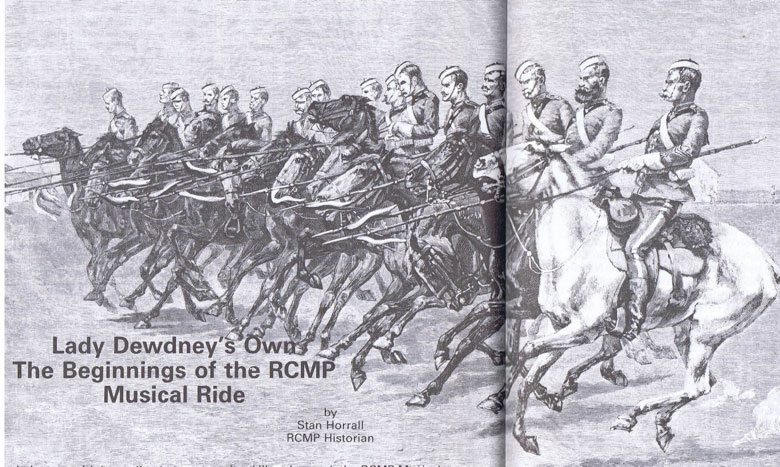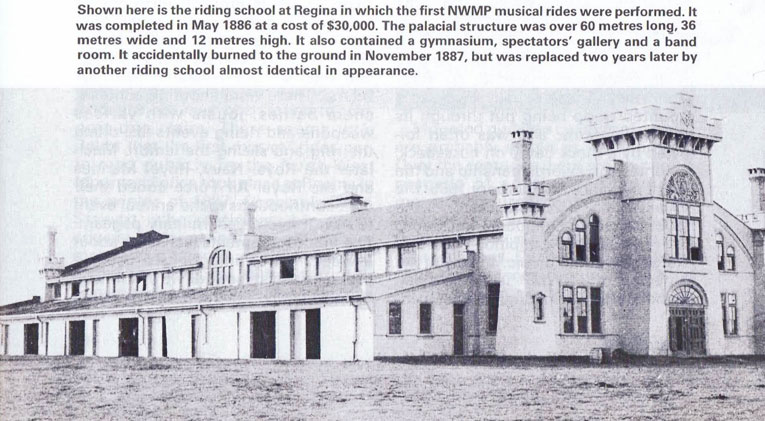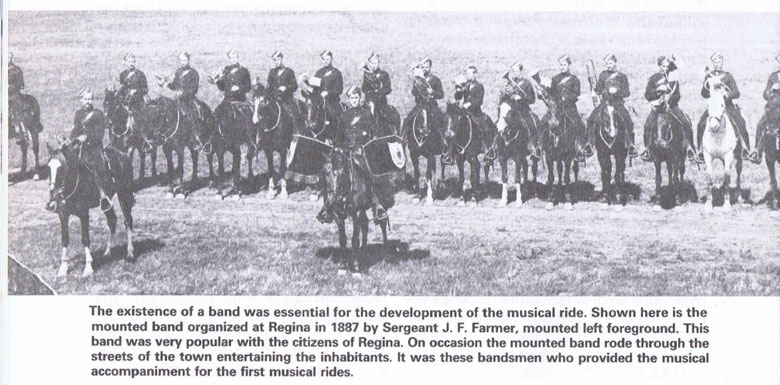
Lifestyle
Lady Dewdney’s Own
The
Beginnings of the RCMP Musical Ride
By Stan Horrall - RCMP Historian
RCMP Quarterly - Summer 1984 p. 46-51
By Stan Horrall - RCMP Historian
RCMP Quarterly - Summer 1984 p. 46-51
 What distinguished a musical ride from these exhibitions of cavalry movements and tactics was the substitution of a brass band for a drill instructor. Instead of responding to words of command, the change from one formation to another was signalled to the mounted troops by a change of tempo or tune in the accompanying music. The result was a non-stop harmonious blend of music, movement and horsemanship. The first known public performance of what was from the start termed a “musical ride” was given by the 1st Regiment of Life Guards at the Royal Military Tournament in London, England, in June, 1882.4 The Royal Tournament, as it is called today, had its start in 1880 as “A Military Tournament and Assault-at-Arms.” The inaugural performance was held in north London at the Agricultural Hall, Islington. At first it consisted largely of competitions between contingents from several British regiments. There were shooting contests, sham battles, jousts with various weapons and riding events like tilting the ring and slicing the lemon. Much later the Royal Navy, Royal Marines and the Royal Air Force added their own contributions to the annual event to turn it into a vast military pageant. The first tournaments lasted for about a week. It was intended to use the profits to assist the widows of soldiers. Unfortunately, for the first two years, 1880-81, the public stayed away in droves and it was a financial flop. This all changed in 1882. That year the 1st Life Guards introduced a musical ride into the program. It was an instant success and the hall which seated 4,000 persons and had standing room for 10,000 more was packed for every performance. Thereafter the musical ride became a permanent and popular part of the spectacle. For many years the 1st and 2nd Regiments of Life Guards took turns annually to put it on. Another popular innovation at the Royal Tournament occurred in 1884 when a display of cavalry movements was presented by the 3rd Hussars. The origins of these first musical rides and mounted displays remain very obscure. Tradition links them with tournaments held earlier by British Volunteer regiments. It is also likely that they had some tie with the experience of the British Army in India, where military pageants that included mounted events had been taking place for some years. There are, however, good reasons to link these developments in London with what was to occur in Regina in 1887. It was the fortunate conjunction of several factors which brought about the appearance of the first Mounted Police musical rides. Strangely enough, Louis Riel and the rebellious Metis of 1885 had a big part in it. It was the unrest of that year and the possibility of further trouble that prompted the government to expand and reorganize the North-West Mounted Police on a more permanent footing. The strength of the Force was increased from 500 to 1,000 men. Annual expenditure upon it also doubled to over one million dollars. An extensive building program was planned for many of the major posts. Among the organizational changes was the establishment of a “Depot” Division at Regina as a permanent training centre. Also planned for Regina was the erection of a large wooden indoor riding school. Hitherto, all mounted training had taken place out of doors. Needless to say, in severe winter weather it was disrupted. A riding school was essential to the organization of a musical ride because it was only during the winter, when the men had been brought in from summer detachments, that there were sufficient riders available to train one. Construction on the riding school began in the summer of 1885. It was not completed until May of the following yer. The building which cost $30,000 dwarfed everything at Headquarters. It was 60 metres long and 36 metres wide with a gallery at one end for spectators and a band. The Regina Leader described it as “one of the finest in the country.”5  The riding school provided the necessary accommodation. Three key individuals now entered upon the scene. The first of these was Reg. No. 1120, George Kempster, who took his discharge from the Life Guards in London in 1884, and came to Canada and joined the Mounted Police in December of that year. The thirty-year old Kempster had also served for several years in the 11th Hussars. Whether he was involved in the first musical rides in London from 1882-84 is unknown, but as a member of the Life Guards stationed there it is unlikely that he would not have known about them. In fact, Kempster turned out to be an outstanding horseman and by 1886 he was the senior riding instructor in Regina with the rank of sergeant major. Next to appear ws Reg. No. 1365, Jacob (Jakey) Farmer, a short, stout man with an unmistakable Cockney accent, who joined the Force in May 1885. Farmer was another veteran of the British Army. He had spent 10 years in H.M. King’s Own Regiment and had considerable experience with military bands. Commissioner Herchmer was a strong supporter of bands in the Force, and in 1886 he appointed Farmer bandmaster with the task of reorganizing the mounted and dismounted bands in Regina. The Commissioner later commended him for their high state of efficiency. Finally, and probably most important, there was Inspector William George Matthews, a forty-year-old former lieutenant and riding master of the 3rd Hussars, a regiment which had had a prominent part in presenting mounted displays at the Royal Tournament Matthews had also spent several years of his service with the regiment stationed in India. He was commissioned an inspector in the NWMP on October 20, 1886. Shortly after his arrival at Headquarters Herchmer appointed him riding master. He took up his new duties just as the men of “B” Division returned to Regina from their summer detachments to spend the winter at mounted and dismounted drill. Just what Matthews and Kempster knew about musical rides at this point, no one will ever know for usure. They were certainly experienced and accomplished horsemen, and together with the new riding school, the men of “B” Division and Jakey Farmer and his band, it was their expertise that put together the first musical rides of the NWMP. There were five public performances of the ride during the winter of 1887. The records of the NWMP reveal very little as to the nature of them. Although they sometimes comprised 16 men instead of 32, from the descriptions of them in the local newspapers they appear to have had most of the elements which are to be found in the RCMP Musical Ride today. The first performance took place in the riding school on Saturday afternoon January 15, 1887. In the spectators’ gallery were Commissioner and Mrs. Herchmer, several other officers and their spouses, as well as a number of guests from town who braved a blizzard and sub-zero temperatures to attend. The reporter from the Regina Leader described the scene: “The band, under Mr. Farmer, was playing a spirited march, and sixteen Mounted Policemen, with lances at rest… were putting their equines through a series of geometrical and other figures with remarkable accuracy and skill, with a most pleasing effect. After going through a number of interesting gyrations, radiating circles and other odd figures, now walking, the next minute trotting, and then breaking into a gallop, the horsemen formed into a line at the opposite end of the pit from the gallery, and as the band struck up ‘Bonnie Dundee,’ cantered forward to the other end, keeping exact time with the music, halted abruptly, broke in the centre, wheeled sharply to right and left, formed fours and cantered back along the sides.”6  The second performance took place on Wednesday, January 26th, but the newspapers did not cover it. The third occurred a month later on February 26th. This time it was a state occasion with His Honour Lt. Governor Dewdney and Mrs. Dewdney in the gallery, and there were 32 riders instead of 16. The newspaper’s brief account describes it as being “heartily applauded by the spectators,” and reflecting “great credit on the drill officers.”7 The next musical ride was presented a few days later on Saturday, March 5th. Once again, the Lt. Governor of the N.W.T. attended, along with deputy ministers from Ottawa, the territorial justices and other local dignitaries. The Leader found this ride similar to the others, but “more interesting and exciting.” Once again there were 32 riders. The charge at the end was so warmly received that at the request of the ladies in the audience Inspector Matthews had it repeated.8 The final ride of 1887 took place on April 5th. As on former occasions the music was under the direction of Bandmaster Farmer. This time the ride commenced with the horses dancing slowly to the accompaniment. Then according to the Regina Journal, “The Company of sixteen horsemen proceeded to go through the drill, evolutionizing and manoeuvering so rapidly as to make it difficult at time to keep track of their movements.”9 A few days later “B” Division headed out for Wood Mountain and its summer detachments. The only illustration depicting these first musical rides is a drawing by the well-known American frontier artist Frederic Remington, which appeared in the December 24, 1887 issue of Harper’s Weekly, a New York magazine. It shows 16 riders charging. The scene, however, is set on the barrack square rather than in the riding school. Whether Remington actually witnessed one of the first performances is not known, although he certainly was in western Canada about that time. The editor of the Regina Leader, who did see the rides, described the drawing as “pretty accurate.”10 Indeed, the detail of the uniform and saddlery is so good it is hard to believe that Remington was not working from real life. Several years would pass before there would be another performance of the musical ride. There were a number of reasons for this. The first and most immediate was that on November 26, 1887, a fire was started in the riding school by a faulty stove in an adjacent harness room. In bitterly cold weather the fire extinguishers were found to be frozen and within minutes the showplace of Headquarters was reduced to a pile of ashes and rubble. In addition, the principals behind the first rides soon moved on to other things. In October 1887, Sergeant Major Kempster purchased his discharge to try his hand at farming. He eventually died in Calgary in 1920. During the winter of 1888, the band was temporarily suspended due to a lack of musicians. It was revived again, but Sergeant Jakey Farmer took his discharge in 1890 to go into business. He turned out to be a much better bandmaster than a businessman and was soon trying to re-engage, but there were no vacancies. Inspector Matthews, meanwhile, had been transferred to Lethbridge where there was a shortage of officers for field duty. Mrs. Matthews had detested Regina. Lethbridge did not improve her view that life on the Canadian prairies was dull and unsophisticated, a colonial backwater. In 1893 Matthews resigned his commission and returned to England. More important in the long run, however, was newspaper criticism. A satirical Toronto weekly called the Grip saw the rides as an example of extravagance by the Conservative government of Sir John A. Macdonald which was sensitive to allegations of misuse of public funds. It published a cartoon which labelled the musical rides as “Lady Dewdney’s Own,” and suggested that murder and robbery were taking place while policemen were being used to entertain the Lt. Governor’s wife and her friends. The message hit home. It would be a while before the Mounted Police again engaged in any such “frills.” Nevertheless, the 1887 rides were well received by the citizens of Regina, who, in an age when the horse was still an important means of transportation, were qualified to recognize the skill they represented. They would not be forgotten. Eventually, there would be requests for a repeat performance. As to the Mounted Police, they saw the potential of the musical ride for promoting good will in the community. A tradition was in the making. The riding school was rebuilt in 1889, but with the departure of Matthews and Kempster it would be a few years before circumstances would again favour the organization of another musical ride. Stewart, J. F. “How the Musical Ride Started” in Scarlet and Gold, Vol. 10, p. 68. Quebec Morning Chronicle, February 16, 1885. Regina Leader, July 9, 1885. Binns, Lt. Col. P. L. The Story of the Royal Tournament, Aldershot, 1952, p. 1. Regina Leader, May 11, 1886. Ibid., January 18, 1887. Ibid., March 1, 1887. Ibid., March 8, 1887. Regina Journal, April 7, 1887. Regina Leader, January 10, 1888. |